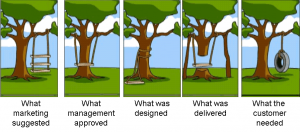
One of the most challenging and critical aspects of being in the field of eLearning is to stay on track with new technologies, tools, best practices, and standards. Like a fighter pilot, the job is to be ready to fly to an unknown destination at the spur of the moment.
My name is Faeyza and I am a software engineer turned instructional designer. I have designed training course mostly, with predefined customer requirements. My main goals for this course are to:
- Play with tools and technologies that I have not explored in my professional environment. My prior experience has mainly been with Adobe Flash (which is dead now), Adobe Captivate, HTML and MS PowerPoint.
- Apply frameworks as a reference to purposefully select learning technologies.
- Create pedagogically aligned courses that are designed to support learners in their learning not merely to assess learners and assign grades.
- Investigate the possibility/ viability/ limitation of using and integrating external software/ social media with LMS keeping usability and learner experience in view.
- Design formative and summative assessment best suited to the course objectives and pedagogical design.
- Explore how to set up student and instructor dashboards with learning analytics that are aligned with course pedagogy (Knight, Buckingham & Littleton, 2013).
The MET program, thus far, has allowed me to experience how the courses are delivered to the students from BlackBoard and WordPress. In ETEC 510, I created a course using the Moodle LMS and got to see how this particular LMS is designed to support K-12 learning. In this course, I am looking forward to creating a course in an LMS different from these three.
Already, in this course, the seven principles highlighted by Chickering and Ehrmann (1996) have instilled the desire to create courses with multiple modes of communication. Bates (2014) SECTIONS model has built an appreciation on how to make informed media and technology choices. So, in context to tool choices, I would like to learn how to choose from among multiple tools with different as well as somewhat similar functionality (for example, Slack vs. WhatsApp)? How to manage audience reaction if they prefer one tool over another?
On the multimedia side, I am looking forward to designing a digital story. I am not sure yet what the context would be, but yes, I want to know what makes a good story? What possible design and format choices exist and what tools can be used for creating and producing digital stories, videos, and animations.
Reflecting on the competencies outlined in NETS, I want to position myself as a Leader and a Designer that eventually sets me on the path to Lifelong Learning. As stated by International Society for Technology in Education (2017), as a leader I would like to “Model for colleagues the identification, exploration, evaluation, curation and adoption of new digital resources and tools for learning” and as a designer, “Design authentic learning activities that align with content area standards and use digital tools and resources to maximize active, deep learning”. Moreover, while I am not a teacher by profession, instructional designers occasionally get to be ad hoc trainers, if not full time, to train and guide people on how to best manage the learning environment that is designed for them. And these training sessions are not necessarily face-to-face but conducted in yet another digital environment. Hence, thinking about the role of a digital-age educator professional, throughout this course, I will try to go back to the NETS competencies and assess myself against them.
This course has already created the motivation to prepare for the journey ahead. I already see a good list of tools and technologies ready for me to explore. To achieve my goals, I would really need to:
- Manage my time well
- Get input on the design, tool choices, and prototype so that I do not spend hours building something only to know that I got it all wrong. Mentoring as suggested by Diaz et al. (2007) would be a great help.
- Not get too creative or excited to lose sight of the assignment because, at the end of the day, the goal is also to do well and ace the assigned tasks! I am reminded of this Tree Swing Cartoon:

References:
Bates, T. (2014). Teaching in a Digital Age. Chapter 8: Choosing and using media in education: the SECTIONS model. Retrieved from https://opentextbc.ca/teachinginadigitalage/chapter/models-for-choosing-media-and-technologies/
Chickering, A. W., & Ehrmann, S. C. (1996). Implementing the seven principles: Technology as lever. AAHE Bulletin, 49, 3-6.
Diaz, V., Garrett, P. B., Kinley, E. R., Moore, J. F., Schwartz, C. M., & Kohrman, P. (2009). Faculty development for the 21st century. Educause Review, 44(3), 46-55.
Knight, S., Buckingham Shum, S., & Littleton, K. (2013). Epistemology, pedagogy, assessment and learning analytics. In Proceedings of the Third International Conference on Learning Analytics and Knowledge (pp. 75-84). ACM.
International Society for Technology in Education (2017). The ISTE Standards for educators. Retrieved from http://www.iste.org/standards/for-educators
Nicol, D. (2007). E‐assessment by design: using multiple‐choice tests to good effect. Journal of Further and Higher Education, 31(1), 53-64.
Walter, S. (2012). Swing Cartoon [Image]. Retrieved from https://swaltersky.files.wordpress.com/2012/02/tire-swing-cartoon.jpg